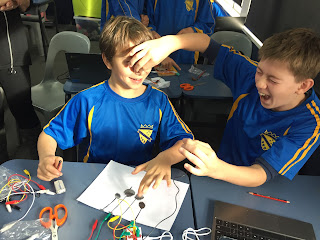Makey Makey
Students will show that they
- can identify the inputs and outputs of a system
- understand that when we give a digital device an input, the device processes it and produces an output
- can use an application to create original content.
Our school recently purchased a set of makey makeys. After teaching the classes how to use scratch I introduced the makey makeys.
I began by showing them an example of a circuit i had made out of carrots, celery, play dough and bananas. We listened to the each object make a musical note and when joined a closed circuit as a class to produce a sound.
After watching a video clip about makey makey http://makeymakey.com/ we then discussed what objects were insulators and conductors of electricity.
Their task was to find 5 objects from around the school that were conductors of electricity and set them up to produce a closed circuit and to play a tune.
 |
| A range of materials were used |
Each of the students did this very well. They had to problem solve if the circuit wasn't working. Some common mistakes were
- not having a wire earthed
- not touching the earthed wire when they were trying to get sound
- using a object that wasn't conductive
They worked through this very well and progressed on to making music by using on of the makey makey apps. Piano or bongo drums
 |
| Double earthed wires required collaboration |
 |
| Lead from the pencil worked well |
 |
| So much engagement from the class |
They discovered they could use parts of their bodies- or other peoples!
 |
| All that hair came in handy! |
 |
| Team work for a closed circuit |
 |
| Honk Honk! |
 |
| All ages enjoyed this |
 |
| Playdough made great keys |
- SCRATCH
Some of the students who were a bit more competent were able to progress onto scratch. They were able to use code to make music playing notes on different instruments.






